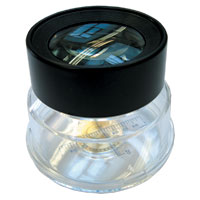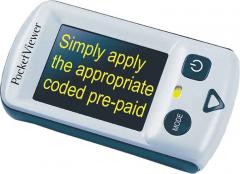Learn More about Types of Magnifiers
Types of Magnifiers
All magnifiers are not the same. They vary based on their power, lens type, and design purpose. Magnifiers can be optical or video-based. Optical magnifiers include hand-held magnifiers, stand magnifiers, spectacles and telescopic devices. Video magnifiers typically employ camcorder-like cameras. Some video magnifiers are hand-held, while others may look like a computer, and still others are head-mounted. Each type of magnifier is designed to offer different benefits and distinct applications.
Power
The power of a magnifier can be measured several ways. The most common, “times magnification” or “power”, refers to how many times bigger an object will appear when viewed through the device as compared to when viewed with the naked eye. The “X” notation on many magnifiers gives the manufacturer’s representation as to the power provided by a given device.
Diopter
A “diopter” is another term that refers to the magnifying power of a device. A diopter is a metric measurement of the lens power. This is a unit of measure that your eye doctor uses when prescribing eyeglasses or contact lenses. The power of hand-held, stand and magnifying spectacles can be measured or represented in diopters or “times magnification”. [While ’X’ power measurements vary from manufacturer to manufacturer, diopters do NOT vary.]
Hand-held, stand and magnifying spectacles are available in power ranges from 1x to 10x. Video magnifiers can provide from 5x to as much as 60x magnification.
Be careful though! Stronger does not mean better! There is a “right” power for each individual and the task they wish to accomplish. This is a process that your Low Vision Specialist is uniquely qualified to determine.
Design types
Various magnifying device designs exist for different purposes. The most common categories are as follows:
Hand-held magnifiers
 Designed for short-term spotting tasks of near objects such as reading menus, price tags and pill bottles. These helpful devices are very portable, versatile and economical, and are available with and without light sources.
Designed for short-term spotting tasks of near objects such as reading menus, price tags and pill bottles. These helpful devices are very portable, versatile and economical, and are available with and without light sources.
Stand magnifiers
 Designed for extended viewing tasks of near objects such as reading books, magazines or newspapers. Stand magnifiers rest directly on the object and are available with and without illumination.
Designed for extended viewing tasks of near objects such as reading books, magazines or newspapers. Stand magnifiers rest directly on the object and are available with and without illumination.
Magnifying spectacles
 Designed for hands-free viewing of near objects for an extended period of time, such as reading, especially in bed.
Designed for hands-free viewing of near objects for an extended period of time, such as reading, especially in bed.
Telescopic devices
 Primarily designed to magnify distant objects. These devices can be hand-held for short-term spotting, or worn as eyewear for extended periods of viewing such as watching television.
Primarily designed to magnify distant objects. These devices can be hand-held for short-term spotting, or worn as eyewear for extended periods of viewing such as watching television.
Electronic Video Magnifiers
 Provide the highest levels of magnification and help to enhance the contrast of objects being viewed. These devices can be hand-held, headmounted, or in a desktop design.
Provide the highest levels of magnification and help to enhance the contrast of objects being viewed. These devices can be hand-held, headmounted, or in a desktop design.
Multiple designs exist to help low vision sufferers accomplish multiple types of tasks. Low vision devices, and magnifiers in particular, can be thought of as tools that the low vision individual keeps in their toolbox, just as a carpenter would.
Different Types of Lenses
Biconvex lens: Distinguised by two spherical (convex) surfaces. Used in large field, low power reading magnifiers. Magnification usually up to 4X.
Aspheric Lens: Aspheric curves allow higher magnification with less distortion. Used by holding the more convex side (side with imprint) towards the eye. Magnification up to 12X.
Aplanatic Lens: Consists of two equally strong plano-convex lenses. The convex sides are arranged face-to-face. Full image is clearly defined and free of distortion. Magnification up to 20X. (Magnification up to 4X useful for persons with macular degeneration.)
Achromatic Lens: Top quality lens. A color-corrected lens system that guarantees a clear, sharp image. Completely distortion free. Magnification up to 25X.
Finding A Magnifier
When choosing a magnifier, it is best to begin with identifying the exact purpose for its use (e.g., reading the newspaper, reading medicine labels, or watching television). Once you have specified the task, categorize the undertaking based on two criteria: the duration of viewing and, the distance of viewing. Distance and duration are the two device criteria, more than anything else, that determine the task appropriateness of a given magnifier design.
Distance
Distance refers to the space between the viewer and the object that is to be seen. This distance bears dramatically on the type of magnifier design required. Distance is categorized as follows:
Near tasks – usually engaged in at a “reading” distance (usually 20″ or closer), these tasks include reading, writing, eating, etc.
Intermediate tasks – usually engaged in at about arm’s length (20″ – to 40″) these tasks can include viewing a computer monitor, reading sheet music, playing cards and other hobbies and handicrafts.
Distance tasks – any visual task that is not near or intermediate (usually 6′ or more). These tasks are dominated by watching television, reading indoor and outdoor signs, watching sporting events, etc.
Duration
This refers to the time period for which you will be using a given device to accomplish a given task. In low vision, it is simplest to think of tasks as follows:
Short-term spotting tasks – engaged in for a maximum of only a few minutes at a time, these tasks include reading menus, reading price tags, writing return addresses on envelopes, reading street signs, etc.
Extended viewing tasks – engaged in for a longer period of time, these include reading books, newspapers or magazines, watching television, writing letters, etc.
The grid table graphically depicts the relationship between the Distance and Duration of the visual task desired and the design category of magnifying devices best suited.
Distance and duration identify the visual goal, and will quickly narrow the range of devices most appropriately suited. The magnifying power required, as well as the need, or desire for illumination, will then further pinpoint the range of options.
Visit our magnifiers page to identify the magnifier best suited for your needs!
